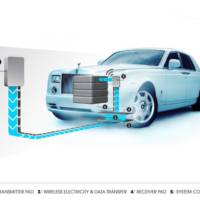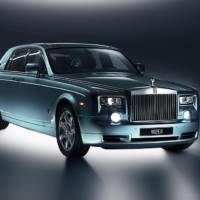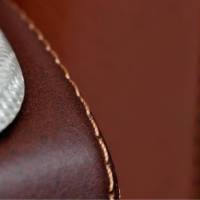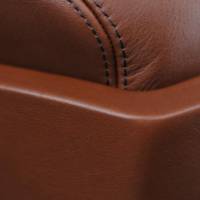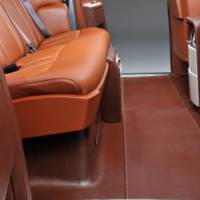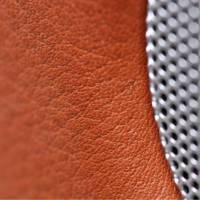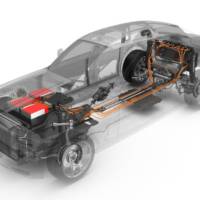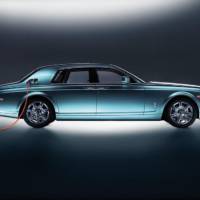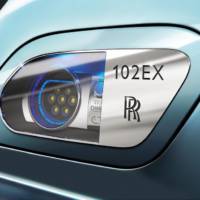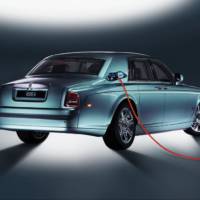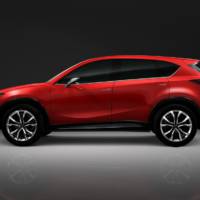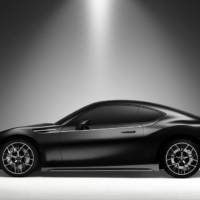Rolls Royce has begun its exploration into alternative drive-trains by introducing the Rolls Royce Phantom 102EX Electric, which looks similar with the regular model, except it extracts power from two electric motors instead of a twin turbocharged V12.
With each of these two electric motors rated at 145 Kw, the Rolls Royce Phantom 102EX Electric develops a total of 290 kW and 800 Nm of torque, which are enough to accelerate the 2.7 ton car from 0 to 60 mph in under 8 seconds and reach a top speed of 160 Kmph.
Pre-launch tests indicate that that lithium ion battery composed from modules filling the gaps where the engine and transmission used to be, and which could be the largest ever fitted in a road car, will enable the Rolls Royce Phantom 102EX Electric to have a driving range of 200 Km.
The 120EX features four charging units, which enable single phase charging (20 hours for a full recharge), three-phase charging (8 hours to recharge) and wireless charging via an induction unit.
Rolls Royce press release :
102EX – PHANTOM EXPERIMENTAL ELECTRIC
INTRODUCTION
“Today, Rolls-Royce Motor Cars begins an exploration into alternative drive-trains, seeking clarity on which technology may be suitable to drive Rolls-Royce motor cars of the future. The alternative drive-train we choose must deliver an authentic Rolls-Royce experience. It must be a technology that is right for our customers, our brand and which sets us on a sound footing for a sustainable future. That is why this project is so important.” – CEO Torsten Müller-Ötvös.
Rolls-Royce Motor Cars proudly presents 102EX, a car that represents one of the most significant initiatives taken by the company in recent years. It is the world’s first battery electric vehicle for the ultra-luxury segment and continues a tradition of experimental cars running through the model generations.
Rolls-Royce produces cars that represent the pinnacle in luxurious motoring for the world’s most discerning customers. However, the company also recognises the need to look to the future and to plan for long-term sustainable growth. An investigation into alternative drive-train options is an important step in that process.
With 102EX, also to be known as the Phantom Experimental Electric (EE), it is the company’s intention to carefully test the opinions and reactions to alternative drive-train options of a range of stakeholders including owners, enthusiasts, members of the public and the media.
Throughout 2011 Phantom EE will serve as a working test bed, giving owners, VIPs, the media and enthusiasts the opportunity to experience an established alternative drive-train technology and to feed back their experiences, thoughts and concerns directly.
The bank of research gathered from a global drive programme that will include Europe, the Middle East, Asia and North America will be crucial to decisions affecting alternative drive-trains for Rolls-Royce Motor Cars.
There are no plans to build a production version of this car. Phantom EE’s role is as a test bed, designed to explore established BEV technologies, to pose as well as to answer questions.
Can Phantom EE deliver an acceptable range for customers without frequent re-charging? Is there confidence in its ability to operate in extreme conditions? Will reliability and quality be consistent with expectations of the world’s pinnacle automotive brand?
Phantom EE also poses more fundamental questions: Is an all-electric drive-train able to deliver an authentic Rolls-Royce experience for customers, an experience that truly befits the marque?
Whether all-electric or another alternative drive-train option is right for Rolls-Royce will become clearer when the test programme is complete at the end of the year.
102EX – PHANTOM EXPERIMENTAL ELECTRIC (EE)
Reinvention is part of being timeless and Phantom EE is the latest in a line of experimental vehicles from Rolls-Royce Motor Cars. It builds on a legacy which dates back to 1919 and 1EX.
Experimental models are used to test and evaluate new technologies and applications which could shape future Rolls-Royce products. Unlike a concept car, Rolls-Royce experimental models are always fully functioning, drivable vehicles using tangible materials such as wood, leather and metals rather than clay and foam or other concepts.
They present engineers and designers with the opportunity for real-world innovation and are used not only to showcase new components and engineering techniques but also to evaluate them.
The latest in this line of experimental projects began with a Rolls-Royce Phantom, a strikingly modern and immaculately proportioned car in which high technology and hand-craftsmanship combine to produce something extraordinary.
Phantom EE features the car’s ground-breaking aluminium spaceframe, so important to dynamic prowess, as well as the sense of calm and tranquillity enjoyed by occupants. However, the naturally aspirated 6.75-litre V12 petrol engine and 6-speed gearbox have been replaced by a lithium ion battery pack and two electric motors mounted on the rear sub-frame. These motors are connected to a single speed transmission with integrated differential.
Each motor is power rated to 145kW, giving Phantom EE a maximum power output of 290kW and torque of 800Nm available over a wide band. This compares with 338kW for standard Phantom with maximum torque of 720Nm, delivered at 3,500rpm.
The Nickel Cobalt Manganese battery chemistry holds around 230Wh/kg,a high energy density which is important in achieving an acceptable range between re-charges. Pre-launch tests suggests Phantom EE should run to a range of up to 200km. Delivered on an effortless wave of torque, 0-60mph will be achieved in under eight seconds (5.7 seconds in standard Phantom), with top speed limited to 160kph.
This is the first application of the technology in a GKL++ segment (super luxury vehicles priced at more than €200,000) and the battery pack is thought to be the largest ever fitted to a road car.
Evaluation of technology is an important part of the test programme. However, more fundamentally the car will seek answers to questions posed of Rolls-Royce owners: what their needs might be for the future considering factors such as range, performance and re-charging infrastructure.
The feedback from customers – as well as media, stakeholders and enthusiasts via the website www.electricluxury.com – will prove essential in evaluating the appropriateness of battery electric technology for Rolls-Royce.
It will help inform a decision on whether all-electric, or another alternative drive-train technology, will be most appropriate for the world’s best cars of the future.
DESIGN
“It’s a credible design concept that perfectly complements the experimental nature of the car, exploring options in light, space and use of materials. Had we changed the overall aesthetic, the concept would have lost credibility; our audience would assume it was simply a styling exercise. The reality is that this is an experimental vehicle in its truest sense, challenging perceptions, emotions and values – as well as exploring alternative drive-train technology.” – Ian Cameron, Chief Designer Rolls-Royce Motor Cars.
102EX bears the famous hallmarks of the Rolls-Royce Phantom on which it is based, such as hand craftsmanship, fine detailing and iconic design cues like the pantheon grille and the Spirit of Ecstasy which celebrates its centenary in 2011. However, at the core of its design is the essence of an experimental vehicle, establishing this car’s status as a test bed, while subtly alluding to its electric power plant.
The design creates a different aesthetic, experimenting with interior space and materials, as well as trims and illumination. These are framed around functional considerations for a battery electric Rolls-Royce – how the car is likely to be used and the changes that the technology brings in terms of interior space and exterior detailing. Naturally, these changes are executed in a way that affirms the car’s credentials as a Rolls-Royce.
ATLANTIC CHROME EXTERIOR
Our designers were challenged with creating a finish for Phantom EE which immediately signified a special car, distinguishing it from standard Phantom models in the absence of many overt design changes. Not an easy task, since all Phantom models are special – with customers benefitting from a range of bespoke paint options running to some 45,000 colours.
Extensive research however had revealed a highly reflective paint using ceramic nano particles. Under a microscope these mimic the impression of a silver metal, but are between 8,000 and 80,000 times smaller than the thickness of a hair or 1,000 times smaller than the size of a normal metallic paint particle.
Test parts were produced and the design team were impressed with the results, knowing that the larger the object covered the better it would look. But they were under no illusions as to the task ahead.
In all sixteen coats of paint were needed, of which four were Atlantic Chrome, and many hours of time dedicated to ensuring a perfect end result. The finish is a striking one. Phantom EE commands the stage, with taut almost chiselled lines giving a wet impression to the car. This only grows in character as light conditions change.
ILLUMINATED SPIRIT OF ECSTASY
As well as the launch of 102EX, 2011 marks another milestone in the history of Rolls-Royce Motor Cars. On 6 February 1911, the design for Charles Sykes’ Spirit of Ecstasy was first registered, signalling the start of a 100 year period in which this famous icon has adorned the prow of Rolls-Royce cars, from the famous Silver Ghosts, Clouds and Shadows of the 20th Century to today’s hand-built Phantom and Ghost models.
Phantom EE’s Spirit of Ecstasy, sits atop the radiator grille above the red double-R badge applied to EX models. Made of Makrolon, rather than stainless steel, it will be bathed in blue LED light, hinting at the electric technology beneath the bonnet. This stunning image complements the keynote graphic of website – www.electricluxury.com – where Rolls-Royce Motor Cars will expand the debate on the question of electric luxury to the online community, taking views from enthusiasts, media and members of the public.
INTERIOR DETAILING
Atlantic chrome-finished dashboard dials echo the exterior colour, providing a sense of interior-exterior balance and their analogue displays maintain the timeless architecture that every Phantom interior commands.
Other changes hint at further evolutionary designs applied to the car. For example, some dials have been subtly modified to provide information needed by the driver of an electric vehicle. The fuel gauge in particular has been replaced by an elegant battery charge indicator.
One of the most pleasing features of every Rolls-Royce Phantom interior is the power reserve dial located beside the speedometer. This reveals how much of the V12 engine’s power remains at a driver’s disposal. Phantom EE takes this concept a step further.
It features a regeneration symbol which takes the dial beyond the normal 100% line of standard Phantom. Depending on the momentum gathered, it conveys the degree of re-charge taking place as the vehicle is in motion.
EXTERIOR RE-CHARGING POINT
Re-charging is undertaken with a plug and five-pin socket which takes the place of the normal fuel filling mechanism for Phantom.The standard fuel filler cap has been replaced by a design featuring a clear window, displaying the RR logo and 102EX motif. The window frames rear-mounted, tricolour LEDs which present the car’s charging status.
On start up, the socket is bathed in blue light. This begins to flash as charging commences. When completely charged, the display turns green, then flashing green as the solenoid is disengaged. A potential fault in the system is indicated by either constant or flashing red light.
Charging can be halted via a switch located adjacent to the plug. The process can also be operated inside the vehicle using controls accessed beneath the centre console, for example when induction charging is taking place.
CENTRE CONSOLE DETAIL
A key identifier for Phantom EE is the design of the centre console charging and display, sited below the central arm rest. A simple switch is used to start and halt charging, while the display itself features a bright plate with an image of a battery, lit by LEDs.
Reflecting the lights applied to the exterior charging point, this image changes colour according to the charge status of the car. A blue-lit battery shows the vehicle is on standard charge, while pulsating blue indicates that inductive charging is taking place. Green indicates a fully charged battery while red notifies engineers of a potential fault in the system.
CORINOVA LEATHER
“At Rolls-Royce we pride ourselves in producing an authentic and natural product for customers, the quality of which is second to none. Seton Corinova is an experimental vegetable-tanned leather that allows us to celebrate more of the curves, creases and other features that are part and parcel of the life of the animal. It’s a more sympathetic process that stretches our understanding of Rolls-Royce interior expectations. Owners’ reactions will prove fascinating during the tour.” – Andrew Monachan, Rolls-Royce Motor Cars General Manager, Leathershop.
Interior wood veneers present Phantom owners with unique grains, patterns and detail adding weight to the fact that every model leaving Goodwood is as unique as the finger print of its owner. Phantom EE takes this concept a step further.
Its leather interior is derived from a natural vegetable tanning process christened Corinova. This gives life to the car, adding definition to the seats, floor and arm rests.
Most leather produced for automotive applications is chrome tanned. This is an important constituent that helps to stabilise animal hides and transfer collagen into leather fibres. The barrel-dyeing process used to colour Phantom interior leathers gives a rich, uniform pigmentation while maintaining the natural feel and softness.
An experimental leather, Corinova distinguishes itself by being entirely chrome free. It starts with a preparation of Glutardialehyde to prepare for tanning. Chestnut extract, sustainably sourced from Southern Europe and Tara powder from crushed fruit of the Tara bush in South America are used for drum-spun colouring. Fruits are harvested without damage to the plant and the product is finished with a combination of natural binders and high tech polymers.
The process lends itself only to certain earthy colours – in the case of Phantom EE a chestnut colour for seat covers and Quebracho Brown for other areas such as the floor and trunk lining, both of which are made of durable saddle leather.
As well as aesthetic differences, Corinova leather presents a number of practical benefits. It uses less paint finish than in standard chrome-tanned leather and creates less waste. It negates the use of petrol-refined products and with further development, it may be possible to use recycled Corinova leather in agriculture to aerate soil.
Rolls-Royce fully expects perceptions to be challenged and first impressions will no doubt focus on appearance, as features that define the life of the animal are more clearly visible in areas like seats and armrests than in production Phantom interiors. A change from the sumptuous finish applied to Phantom leather may imply a compromise to some owners, but others may welcome distinguishing features that stretch individualisation for Rolls-Royce Phantom models ever further.
As well as gauging owner feedback, the leather will be tested for its durability and performance after several months on tour.
INTERIOR PANELS
The interior of Phantom EE represents a departure from the traditional wood sets that define the majority of cars delivered to customers, providing a unique finish to the car. It features a distinctive aluminised foil weave that lifts the environment of the interior, contrasting sharply with the darker natural leather within. As is the case with Corinova leather, the aim is to challenge traditional perceptions of what might constitute a Rolls-Royce interior design scheme.
BATTERY PACK
Phantom EE is thought to have the largest passenger car battery in the world. Peak current is 850A, delivered at 338V DC. Overall capacity is 71kWh.
The pack is comprised of large-format NCM pouch cells. NCM (Lithium-Nickel-Cobalt-Manganese-Oxide) is a variant of lithium-ion chemistry that has particularly high energy and power densities.
The Phantom EE battery pack houses five modules of cells, a 38-cell module, a 36-cell module, and three smaller ones of ten, eight and four arranged in various orientations within an irregular shaped unit. This resembles the overall shape of the original engine and gearbox.
Each of the 96 cells was individually tested before assembly into modules to determine their characteristics and capacity. Sub-assemblies were further tested under load to verify that the power connections between each cell perform to specification.
The electronic sensing units for each group of cells were tested and calibrated prior to assembly and put through a rigorous temperature cycling regime designed to provoke failure of weak components. The main electronic box, which contains the switching and control gear, was tested in isolation from the other components to verify correct operation.
Three separate charger units (3kW each) are fitted to the battery, which allow both single-phase (20 hours) or three-phase charging (8 hours); for a passenger car this is unique. A fourth induction charger is also fitted to enable wireless charging, a technology being trialled in Phantom EE.
The battery pack would be expected to last over three years were it to be used every day. Part of the programme however will be to test this assumption in a real world environment and deliver a more robust answer to the question of battery lifespan.
INDUCTION CHARGING
Concerns about lack of available re-charging infrastructure in towns and cities are well documented and critics of electric motoring point to the additional inconvenience of trailing cables connected between power source and vehicles.
To present Rolls-Royce owners with a vision of a potential solution to these problems, Phantom EE is testing a technology called induction charging. This allows re-charging to take place without any physical connection, delivering greater convenience for owners and hinting at the potential for a network of remote charging facilities.
There are two main elements to induction charging; a transfer pad on the ground that delivers power from a mains source and an induction pad mounted under the car, beneath Phantom EE’s battery pack. Power frequencies are magnetically coupled across these power transfer pads.
The system is around 90 percent efficient when measured from mains supply to battery and it is tolerant to parking misalignment. For example, it is not essential to align the transmitter and Phantom receiver pads exactly for charging to take place. While pads are capable of transmitting power over gaps of up to 400mm, for Phantom EE the separation is in the region of 150mm.
The coupling circuits are tuned through the addition of compensation capacitors. Pick-up coils in the receiver pad are magnetically coupled to the primary coil. Power transfer is achieved by tuning the pick-up coil to the operating frequency of the primary coil with a series or parallel capacitor.
The pick-up controller is an essential part of the technology because it takes power from the receiver pad and provides a controlled output to batteries. It is required to provide an output that remains independent of the load and the separation between pads. Without a controller, the voltage would rise as the gap decreases and fall as the load current increases.
The transmitter pad has been constructed to shield magnetic fields to prevent EMI egress to bystanders and the system operates well within internationally agreed limits.
ELECTRIC CARS AND THE FOUNDING FATHERS OF ROLLS-ROYCE
Charles Rolls, Henry Royce and Claude Johnson played their part in an electrical revolution that pre-empted the establishment of internal combustion as the dominant car engine technology.
Henry Royce had developed a career as an accomplished electrical engineer before turning his expert hands to car manufacturing.
His business F.H. Royce and Co, which began selling simple lights and bell sets in the 1890s, became prosperous through the design and delivery of dynamos, electric motors and industrial cranes. Royce’s many innovations include the patent for the bayonet bulb holder, a design that endures today.
One of Royce’s clients was Pritchett and Gold, a company based in Feltham in Middlesex. As well as manufacturing accumulators they had developed a two-seater electric car, at least one of which was powered by a Royce electric motor.
The Honourable Charles Rolls also toyed with electric motoring in the years before the two men met. He had negotiated for the selling rights of an electric brougham, through C.S Rolls and Co, in Conduit Street, London which latterly established exclusive rights to sell Rolls-Royce models.
It is likely that this car was part of the City and Suburban Electric Car Project, a joint venture of two men, Paris Singer and one Claude Johnson. The project had a short life and Johnson left to join the rapidly expanding business of Rolls, latterly taking the role of managing director of Rolls-Royce. He became known as ‘the hyphen in Rolls-Royce’, with a pivotal role in its success.
Charles Rolls was on record outlining the merits of electric drive-trains – as well as raising prescient concerns about range and re-charging. He regarded a model called the Columbia as the best of its type, commenting in Automobile Journal:
“They are perfectly noiseless and clean. There is no smell or vibration and they should become very useful for town use when fixed charging stations can be arranged. But for country use I do not anticipate they will be very serviceable – at least not for many years to come.”
Later, when the first exports of petrol powered Rolls-Royce models were made to America, some authorities refused to believe they were not electrically powered, thanks to their legendary near-silent running.
In the 21st Century silence remains a key signature for Rolls-Royce cars. Other attributes of all-electric drive-trains also allude to famous Rolls-Royce characteristics. Power at low speeds is one example.
Thanks to improvements in battery technology, it may be that the serviceability to which Rolls referred more than a century ago is now sufficiently developed to re-visit all-electric motoring as an option.
And to pose a 21st Century question of customers, enthusiasts and the media:
Electric luxury – can it be perfection or does it present an unacceptable compromise for Rolls-Royce Motor Cars?
www.electricluxury.com
TECHNICAL SPECIFICATIONS
No of doors/seats 4 / 5 (optionally 4)
Vehicle length 5840 mm / 229.9 in
Vehicle width 1990 mm / 78.3 in
Vehicle height (unladen) 1638 mm / 64.5 in
Wheelbase 3570 mm / 140.6 in
Turning circle 13.8 m / 45.3 ft
Track, front 1687 mm / 66.4 in
Track, rear 1671 mm / 65.8 in
Width at shoulder height, front 1509 mm / 59.4 in
Width at shoulder height, rear 1431 mm / 56.3 in
Leg room, front 1028 mm / 40.5 in
Leg room, rear 1109 mm / 43.7 in
Head room, front 1051 mm / 41.4 in
Head room, rear 979 mm / 38.5 in
Boot volume (DIN) 460 ltr / 16.2 cu ft
Unladen weight (DIN) 2,720 kg
Gross vehicle weight 3,030 kg
Payload 300 kg
Axle load limit, front 1,473 kg
Axle load limit, rear 1,548 kg
Maximum power output 290 kW
Torque 800 Nm
Battery:
Chemistry NCM (Lithium-Nickel-Cobalt-Manganese-Oxide) li-ion
Number of cells 96 in pouch design
Capacity 71kWh
Battery pack weight 640 kg
Peak current 330 kW at 850 Amps
Charge time (est) 20 hours single phase / 8 hours three-phase
Transmission type Single speed 6:5:1 with integral differential
Steering type EHPS Rack and pinion, speed-sensitive
variable-rate power assistance
Brakes
Front / diameter Ventilated disc / 374 mm / 14.7 in
Rear / diameter Ventilated disc / 370 mm / 14.6 in
Drag Cd 0.37
Drag Cd x A 1.041m2 / 11.2 ft2
Top speed 160 kph (governed)
Acceleration 0-60 mph Under 8 seconds
CO2 emissions Nil
Tyre, front Goodyear EMT 255/50 R21 106W
Tyre, rear Goodyear EMT 285/45 R21 109W
Wheels (21 in alloy)
Wheel size, front 8 in x 21 in
Wheel size, rear 9.5 in x 21 in
12V Battery capacity / installed position 90+70 Ah / boot
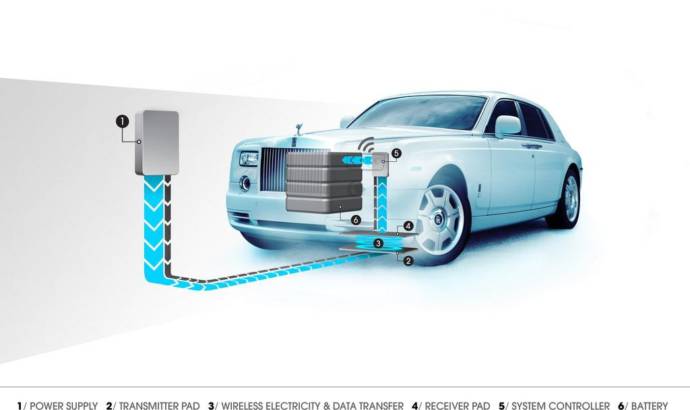
01 Mar 2011
0

